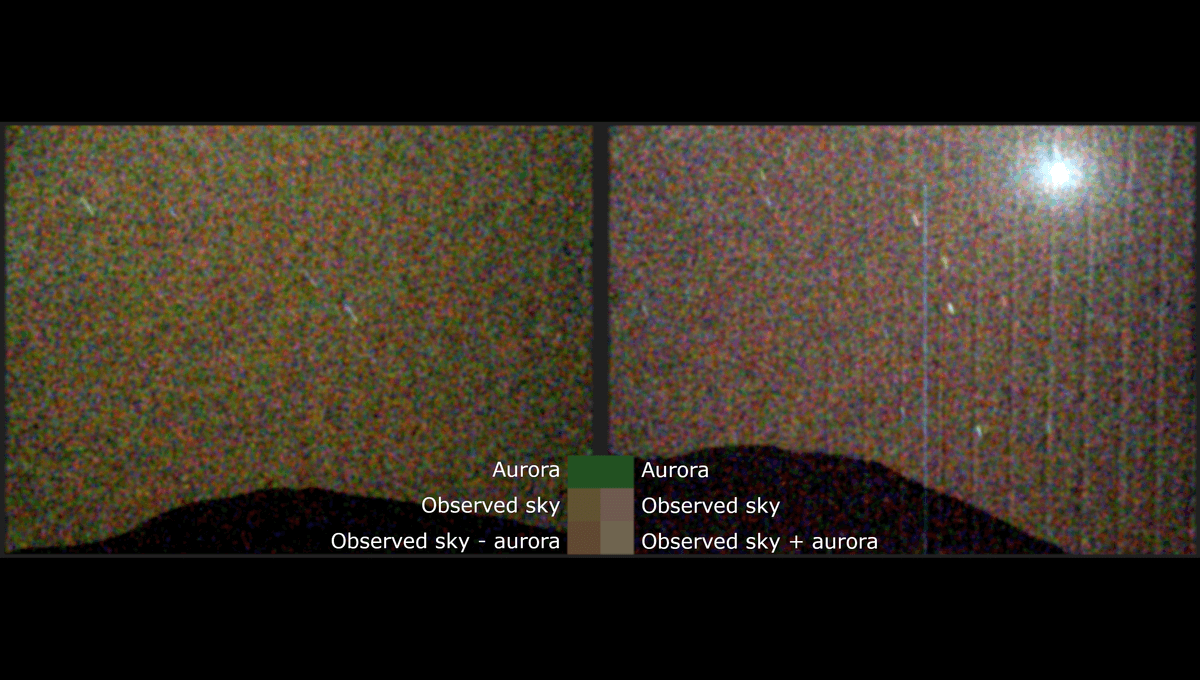
Astronomers have reported an incredible new observation: Mars not only has the bizarre proton aurorae that have been detected from orbit, it also has green aurorae like those here on Earth, generated by charged solar wind particles hitting the very scarce oxygen atoms in the thin Martian atmosphere. This is not only the first detection of visible light aurorae on Mars, it is also the first detection of any type of aurora from the ground on a planetary body other than Earth.
The observation was made possible thanks to carefully forecasting possible auroral activity on the Red Planet and the great tech on NASA’s Perseverance rover.
It took three unsuccessful attempts before we got it right, but when we did, it appeared exactly as we had imagined it; as a diffuse green haze, uniform in all directions.
Dr Elise Wright Knutsen
“For the first time ever, visible aurora has been observed on Mars. It was observed using two instruments on the Mars 2020 Perseverance rover, the SuperCam spectrometer and the Mastcam-Z camera,” lead author Dr Elise Wright Knutsen, from the University of Oslo, told IFLScience.
“Using these two instruments, we not only identified the exact spectral line causing the green emission (557.7 nm), but also photographed the softly glowing sky. As we know from Earth, aurora appears when solar storms and charged particles impact on the atmosphere, but knowing exactly when the aurora will appear is tricky. Aurora forecasting at Mars is even more challenging than on Earth.”
Mars has no magnetic field like Earth; its atmosphere is just 1 percent as dense as ours. The interactions between its atmosphere and the charged particles in the solar wind were unlike what we are used to in the high-latitude regions here. It took a lot of work and some letdowns, but the team’s hard work paid off.
“We spent a lot of time developing the exact instrument settings and fine-tuning the timing of our observations,” Dr Knutsen told IFLScience. “When a coronal mass ejection seemed to be Mars-directed, we used simulations published online by the NASA Community Coordinated Modeling Center to evaluate if the CME was likely to trigger an aurora bright enough for our instruments to detect. It took three unsuccessful attempts before we got it right, but when we did, it appeared exactly as we had imagined it; as a diffuse green haze, uniform in all directions.”
The fact that Mars doesn’t experience aurorae like Earth has one advantage: they are not restricted to only the higher latitudes. Perseverance is exploring Jezero crater, just 18 degrees north of the Equator. Despite the wider range, there are several reasons why it took until now to find them.
“Firstly, the visible-wavelength instruments we have at Mars on satellites and on the ground are mostly designed to observe the bright dayside of Mars, and not to detect faint emissions on the nightside,” Dr Knutsen told IFLScience. “The few that are capable of making the detection rarely observe the nightside at all. Secondly, satellites can’t react quickly to a sudden solar event, so you’d have to be very lucky to accidentally catch the aurora. You need to take the image at just the right time, and figuring out the timing along with the instrument settings takes quite a bit of time and effort.”
“With the Mars 2020 Perseverance rover, we are lucky that we have both the right instrumentation with SuperCam and Mastcam-Z, and people willing to respond quickly and change observation schedules to observe the aurora on short notice.”
According to Knutson, it might be possible to observe the aurora, or at least detect them with instruments, even when it is not night.
“The aurora we observed here was on the nightside, but it is quite likely this aurora also appears on the dayside (we have dayside aurora on Earth all the time, just too weak for us to see),” Dr Knutsen told IFLScience. “SuperCam could perhaps distinguish the green line emission on the dayside, but the additional green aurora signal would likely be too faint compared to the bright dayside sky for it to be distinguishable in a Mastcam-Z image.”
One of the things that the worlds of the Solar System seem to have in common, whether they are gas giants or comets, is aurorae. Just this year, astronomers found the lost Neptune aurorae, finally completing the set of all eight planets with aurorae. The new visible Martian ones join a large family of events across the Solar System and beyond.
The study is published in Science Advances.
Source Link: First Ever Visible Green Aurorae Seen On Mars